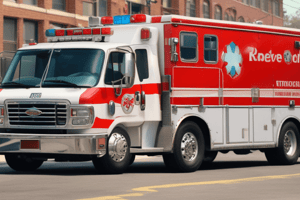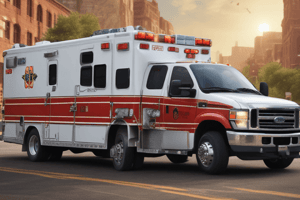Podcast
Questions and Answers
What is the primary responsibility of Fire Rescue personnel when treating patients?
What is the primary responsibility of Fire Rescue personnel when treating patients?
- To prioritize their own safety during operations
- To ensure patient treatment and transportation is effective and efficient (correct)
- To make decisions solely based on hospital policies
- To maintain communication with family members during transport
When should a patient be transported in an MDFR Rescue Unit?
When should a patient be transported in an MDFR Rescue Unit?
- Only when the patient has a stable condition
- For all non-serious injuries regardless of condition
- Only if the patient requests it
- When there are doubts about the patient’s condition or stability (correct)
What should happen if there is a conflict regarding patient care decisions during a rescue?
What should happen if there is a conflict regarding patient care decisions during a rescue?
- The OIC should be informed after the patient is transported
- The concern should be directed to an EMS Field Supervisor after patient care (correct)
- Transport should proceed without addressing the concern
- The dispute should be resolved immediately on the scene
What is required when transferring a patient to a transport unit?
What is required when transferring a patient to a transport unit?
What determines the transportation destination for unstable ALS patients?
What determines the transportation destination for unstable ALS patients?
Which factor is considered when transporting stable patients?
Which factor is considered when transporting stable patients?
What should Fire Rescue personnel do if they believe a patient care decision may negatively impact the patient?
What should Fire Rescue personnel do if they believe a patient care decision may negatively impact the patient?
Which statement about patient care responsibility is true?
Which statement about patient care responsibility is true?
What should be done if there is an unresolved disagreement on the treatment or transport modality?
What should be done if there is an unresolved disagreement on the treatment or transport modality?
Which of the following criteria warrants transportation to the closest STEMI Center?
Which of the following criteria warrants transportation to the closest STEMI Center?
When should a non-transport unit request an ambulance/BLS transport unit?
When should a non-transport unit request an ambulance/BLS transport unit?
What is the role of the OIC in deciding to transport a patient using emergency lights and sirens?
What is the role of the OIC in deciding to transport a patient using emergency lights and sirens?
Which of the following patients requires ALS treatment and transport?
Which of the following patients requires ALS treatment and transport?
Why is it important to document all orders received via online Medical Control?
Why is it important to document all orders received via online Medical Control?
What is the protocol for transporting a stable pregnant patient with less than 20 weeks gestation?
What is the protocol for transporting a stable pregnant patient with less than 20 weeks gestation?
Under which circumstances can a trauma patient be transported to a non-Trauma Center?
Under which circumstances can a trauma patient be transported to a non-Trauma Center?
What is a crucial consideration when deciding on Air Rescue transportation?
What is a crucial consideration when deciding on Air Rescue transportation?
Who may a non-transport unit OIC consult for assistance with treatment or transport decisions?
Who may a non-transport unit OIC consult for assistance with treatment or transport decisions?
What action must be taken for patients with suspected GI/GU bleeds?
What action must be taken for patients with suspected GI/GU bleeds?
What documentation is required when transferring care to an ambulance/BLS transport unit?
What documentation is required when transferring care to an ambulance/BLS transport unit?
What conditions warrant ALS treatment and transport specifically related to headaches?
What conditions warrant ALS treatment and transport specifically related to headaches?
What is a requirement for patients transported via MDFR Rescue for trauma?
What is a requirement for patients transported via MDFR Rescue for trauma?
What is required before an accompanying family member is allowed on the aircraft during child transport?
What is required before an accompanying family member is allowed on the aircraft during child transport?
What is the protocol if a patient is found to possess a weapon during transport?
What is the protocol if a patient is found to possess a weapon during transport?
Which service animal is permitted to accompany a patient during transport?
Which service animal is permitted to accompany a patient during transport?
Under what condition can a patient be released at the hospital?
Under what condition can a patient be released at the hospital?
What constitutes alternate transport?
What constitutes alternate transport?
What characteristic defines a stable patient during transport?
What characteristic defines a stable patient during transport?
Which scenario describes a suspected labor situation?
Which scenario describes a suspected labor situation?
What is the role of the Medical Control Physician?
What is the role of the Medical Control Physician?
What criteria classify a patient as unstable?
What criteria classify a patient as unstable?
Which of the following describes appropriate documentation procedure?
Which of the following describes appropriate documentation procedure?
Which complications of pregnancy would require immediate intervention?
Which complications of pregnancy would require immediate intervention?
What is the definition of a trauma center?
What is the definition of a trauma center?
When can a service animal interfere with patient care?
When can a service animal interfere with patient care?
What must a patient provide regarding their service animal?
What must a patient provide regarding their service animal?
Flashcards are hidden until you start studying
Study Notes
Patient Treatment Protocol
- Emphasis on effective transportation and treatment of all patients with illness or injury per guidelines.
- Fire Rescue personnel must prioritize patient welfare and collaborate as a team.
- ALS Units are to be used for patient transport upon request of non-transport units without delay.
Transportation Destination Guidelines
- Unstable ALS patients are transported to the nearest appropriate facility; stable patients go to the most suitable facility based on specialized needs or requests.
- Doubts about patient stability necessitate transport to the most appropriate facility.
- STEMI and Stroke patients are prioritized for transport to designated centers.
Conditions Requiring ALS Treatment and Transport
- Long bone fractures, loss of consciousness, cardiac symptoms, severe headaches, hip fractures/dislocations, and generalized abdominal pain necessitate ALS transport.
- Female patients of childbearing age must follow specific transport protocols.
Transportation Modes and Decision-Making
- Non-transport units manage protocols until transport unit arrives; capable of initiating assessments and documentation.
- Decisions on emergency transport using lights and sirens fall to the OIC's discretion.
- Assistance from medical control or EMS supervisors is available for treatment and transport decisions.
Trauma and Air Rescue Protocols
- Trauma patients must be sent to the nearest Trauma Center unless airway establishment is an issue.
- Air Rescue is considered for critically ill patients if transport time exceeds 20 minutes.
Weapons and Safety Procedures
- If a patient possesses a weapon, Fire Rescue personnel should withdraw and contact law enforcement; the patient cannot be transported until the weapon is surrendered.
Service Animals
- Service dogs may accompany patients but must be tethered; alternate transport is used if the service animal interferes with care.
Patient Transfer at Hospital
- A face-to-face transfer of care is mandatory upon hospital arrival; documentation must include names and titles of receiving staff.
Documentation Requirements
- An electronic Patient Care Record (ePCR) must be completed for EMS dispatches unless cancelled beforehand.
Definitions
- Clarifications include distinctions between alternate transport, stable and unstable patients, and criteria for trauma transport.
- Emphasizes the importance of accurate documentation in ePCR for any transport decisions made.
Studying That Suits You
Use AI to generate personalized quizzes and flashcards to suit your learning preferences.




